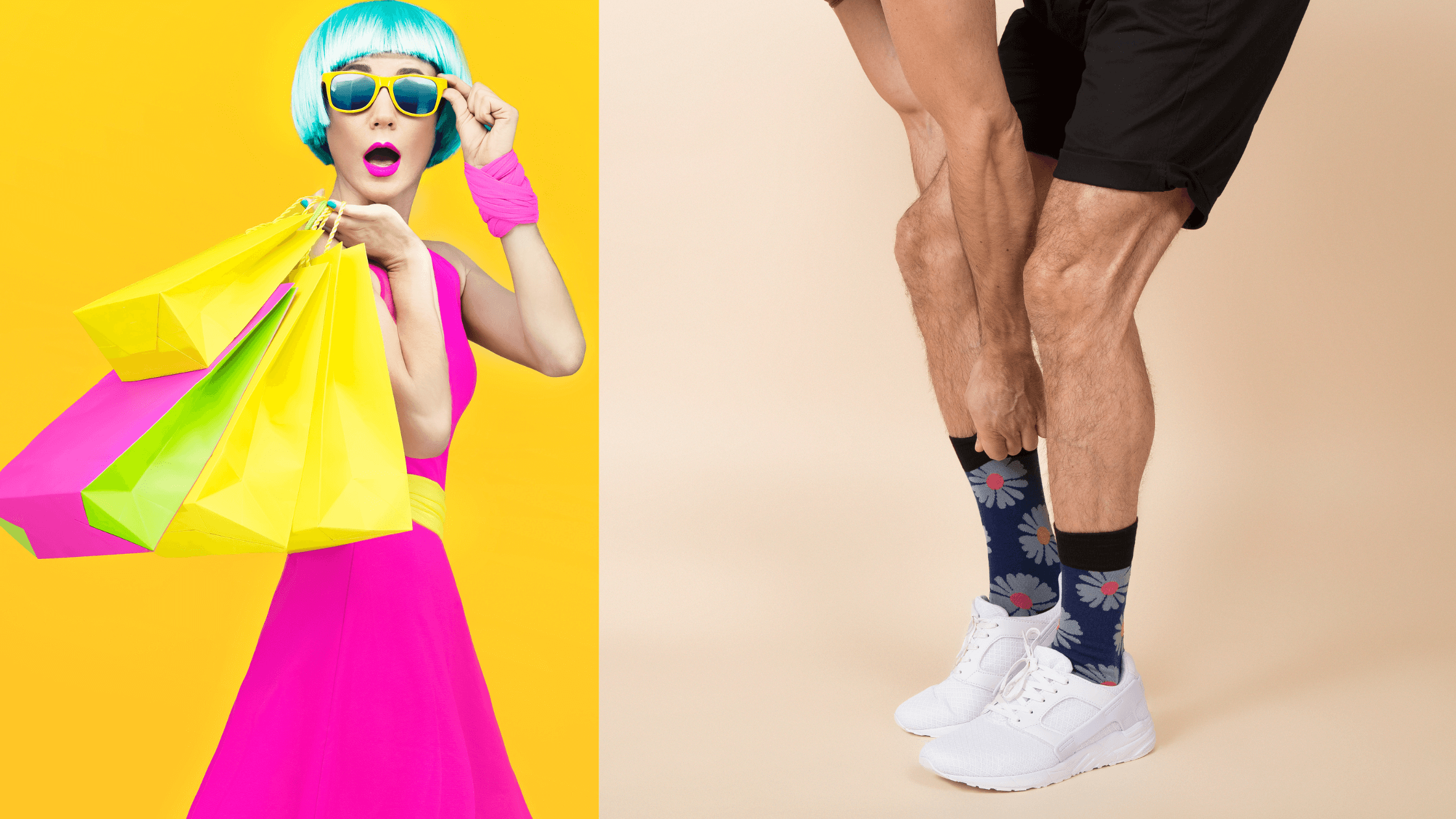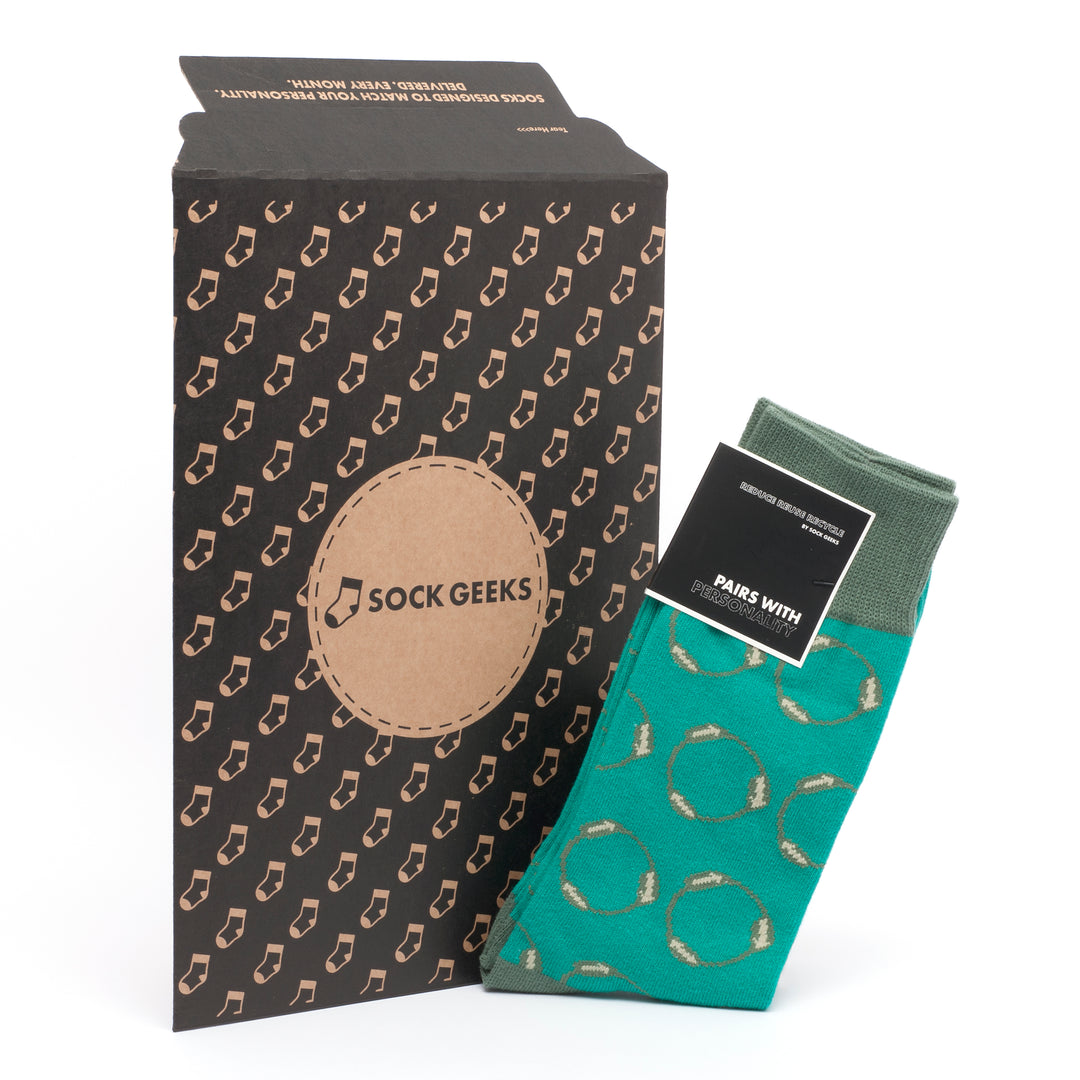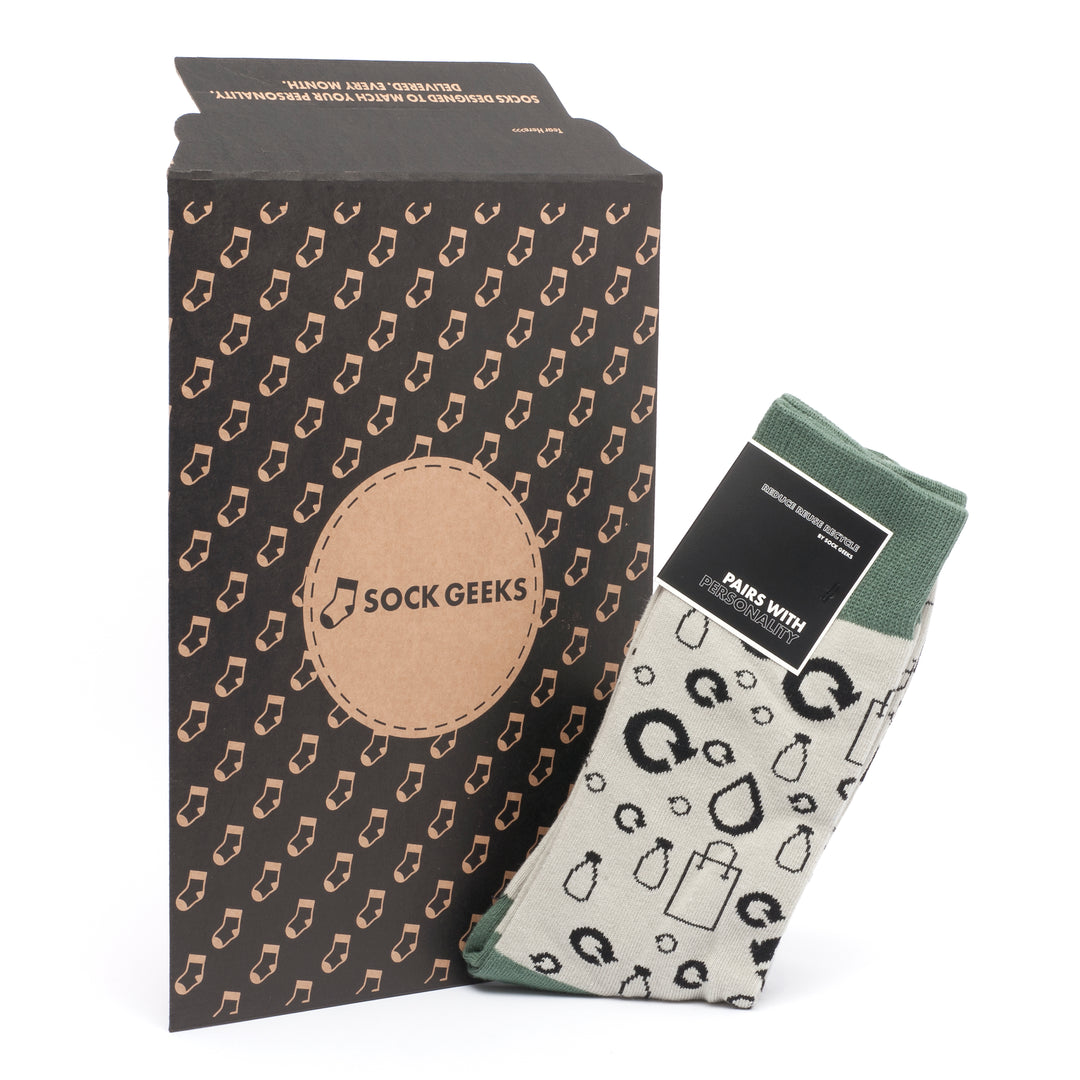Are Your Socks Cutting Off Circulation?
Key Takeaways
- If socks have tight elastic bands, they can cut off circulation, leaving severe sock marks and cutting off blood flow as well. Avoid socks that have elastic that is too tight and could cut off circulation.
- Synthetic or non-stretchy materials in socks can make pressure points and aggravate swelling. Choose softer materials such as cotton or bamboo to help enhance airflow and circulation.
- Wearing socks too many hours a day can cause fluid retention and swelling. Make sure to take lots of breaks to let your feet breathe and keep good circulation.
- Poor sock sizing, either too tight or too loose, can restrict circulation and lead to pain. Measure your feet properly to ensure you choose the right size for the best fit.
- If you are experiencing persistent sock marks, swelling, or pain, then these can be signs of underlying health issues like diabetes, vascular conditions, or lymphedema. Please see a healthcare provider if symptoms continue.
- Circulation issues can be prevented by ensuring socks are well fitted, made from breathable fabrics, and not worn for prolonged periods of time. Elevating your legs and drinking plenty of water are other ways to improve circulation.
Socks that are too tight can cut off circulation, which can cause pain or swelling in your feet and ankles. This happens most often when the elastic bands at the toe or the top of the socks constrict the foot or ankle. It’s more likely if you wear them for extended amounts of time.
Prolonged such pressure can lead to indentations or redness over time, a sign of compromised circulation. Opting for socks that fit a bit looser or are seamless can avoid the cut off circulation without compromising on the support socks that provide.
Breathability helps prevent irritation and sock materials such as cotton or bamboo blends are an excellent option. Monitoring the fit and condition of your socks helps you make sure they’re comfortable and safe enough for everyday use.
Healthy circulation is extremely important when it comes to foot health and comfort in general.
What Causes Circulation Issues from Socks
Usually, it’s a combination of design, material, and usage habits that lead to circulation issues caused by socks, particularly with diabetic socks and compression stockings. These elements play a huge role in blood circulation, delicate comfort, and foot wellness. Knowing how each contributes to the problem can help you choose the right socks to avoid discomfort—and the deeper problems a circulation issue from socks can have.
1. Tight Elastic Bands in Socks
Elastic bands or elastane in socks deliver the tension required for compression and give socks their stay-up power. Very tight elastic bands can form a tourniquet, cutting off circulation around the ankles. This can lead, in extreme cases, to pain and negative sock-dent aesthetic outcomes, a hallmark of undue skin pressure.
If you have compromised circulation, beware of any tight bands. If left unaddressed, regular use can cause long-term issues such as persistent swelling or numbness. Choosing socks with the right amount of elastic gives you the support you need while still allowing blood flow and comfort.
2. Poor Sock Material Choices
The socks’ fabric composition plays a critical role in their overall comfort, breathability, and flexibility. In addition to compromising the stretch properties of fibres, synthetic fabrics often produce hard, pressure points on the skin that constrict blood flow.
Non-breathable materials trap moisture, which can contribute to swelling and irritation. Natural or blended fibres such as cotton or bamboo, which are breathable and moisture-wicking, tend to be the most comfortable. Choosing stretchy materials helps with the fit, minimizing the risk of discomfort and circulation issues.
3. Wearing Socks for Extended Periods
Wearing socks that do not fit properly over extended periods of time can cause sock related fluid retention in the feet and ankles. This continued pressure can lead to oedema, especially in hot temperatures or after long periods of exertion.
Removing socks periodically to give the skin a chance to breathe and improve circulation is beneficial. Replacing socks more often while exercising or similar can help prevent problems too, as sweat and friction over time increase the chance of irritation.
4. Incorrect Sock Size or Fit
Wearing a badly fitted sock can create pressure points and limit blood flow. Socks that are too tight can pinch toes or compress feet, while pairs that are too large can bunch up and cause pressure points.
Measuring your foot size accurately before buying socks is key to getting the right fit. A properly sized sock encourages healthy circulation and minimizes rubbing and chafing, leading to improved foot health all around.
5. Underlying Health Conditions
Some health issues may make people more sensitive to sock fit and worsen circulation problems. Diabetes, Raynaud’s syndrome, or peripheral artery disease (PAD) are frequent offenders.
Individuals suffering from any of these conditions should speak to healthcare providers to select the best sock types to improve circulation. If you notice persistent sock marks, numbness, or discoloration, speak to a healthcare professional about the possibility of an underlying issue.
External causes such as smoking or high cholesterol, which both damage arteries, can aggravate circulation issues.
Signs Your Socks Are Too Tight
Wearing socks that are too tight can lead to foot pain and other health issues, such as swollen ankles and persistent discomfort. Recognizing the signs of improper fit will help ensure healthy feet and prevent problems down the line.
Red Marks or Indentations on Skin
Red marks around your leg, usually created by the sock’s top band, can denote tightness. If your legs are a bit less puffy tomorrow, those marks may disappear in a matter of hours. Temporary impressions are normal, but permanent indentations might indicate circulatory issues.
If red marks stick around long after your socks come off, it’s time to consider a better-fitting pair. Choose one size, thickness or style up that fits without binding.
Swelling Above or Below the Sock Line
Swelling above and below the sock line may indicate reduced circulation. Pay close attention to whether your swelling is localized or systemic. For example, swelling limited to one foot or leg can indicate a more serious condition.
Acute swelling, especially if accompanied by new-onset chest pain or shortness of breath, needs emergency evaluation. Compression socks, if poorly fitted, can actually increase swelling, so get advice from a healthcare professional to get the right size.
Tingling or Numbness in Feet
Tingling or numbness can be caused by nerve compression or loss of blood flow from excessively tight socks. If these feelings continue even when socks are removed, you may want to look for options that fit looser or are made with a softer material.
If they happen often and/or with redness, warmth, or pain, a doctor's examination is needed. When fitted properly, medical-grade compression socks can be very beneficial for circulation. At a compression level of 15 to 20 mmHg, they work to prevent pain in those predisposed to issues such as varicose veins or diabetes.
Persistent Discomfort or Pain
If discomfort or pain persists over the course of the day, it’s a sign that socks aren’t fitting properly and improvements should be made. Socks that are overly tight may increase the sensitivity of the foot or leave clear impressions.
If you have ongoing pain even after making adjustments, try a new style of sock or consult a medical professional. If you experience persistent discomfort associated with tight socks, it could indicate deeper health issues that need to be addressed as soon as possible.
Differentiating Normal and Concerning Sock Marks
Sock marks are a normal, daily occurrence, but recognizing when that sock mark indicates a potential health issue is crucial. While temporary marks can typically be dismissed, persistent or unusual marks may require further investigation. Understanding how to distinguish between normal and concerning sock marks can help prevent issues like swollen ankles or venous disease. This proactive approach ensures that your lower limb health remains a priority.
1. Understanding Harmless Sock Marks
Non-concerning sock marks are typically superficial indentations that resolve within minutes or a few seconds after socks are removed. These markings often come from elastic indentations on the dermis and usually occur after long-term use or in hot weather when moderate swelling is a natural occurrence. Compression stockings can help alleviate unwanted swelling and provide support for sensitive feet, especially when worn during physical activities.
Usually, these types of marks appear in situations where compression socks stretch with motion, providing compression without sacrificing comfort. Consistent movement and periodic changes in position, like getting up from sitting or walking after standing, can help ensure these marks don’t develop into something more serious.
Keep in mind that good hydration helps with light swelling, and wearing the right socks can significantly improve comfort and circulation. Choosing appropriate footwear and maintaining proper sizing for your compression stockings are essential for overall foot health.
2. Recognising Worrisome Sock Marks
Sock marks that do not quickly resolve, leave a permanent change in skin colour or develop associated swelling or pain can be worrisome. If marks do not improve, this may suggest vascular compromise or edema (especially worsening swelling throughout the day).
Symptoms of redness, tenderness, or warmth may indicate deep vein thrombosis or cellulitis. Swelling that is only in one foot or leg, or is in addition to heart or kidney disease, needs urgent evaluation.
Keeping a record of these episodes can make it easier to spot trends and can inform more productive conversations with medical providers.
3. Monitoring Additional Symptoms
When other symptoms are present, such as extreme swelling, change in skin color or texture, or pain, the concern is even greater. New onset swelling of the calf could be a sign of a blood clot. Generalized swelling might be indicative of systemic processes like kidney or liver disease.
If your child is experiencing severe symptoms such as chest pain, confusion, or fainting, seek emergency medical attention right away. A simple checklist, such as the presence of localised redness, warmth, or reduced mobility, helps ensure they’re looking closely.
Patterns that link sock marks with these symptoms should raise concern.
4. Checking Frequency and Duration of Marks
If sock marks occur often, or are deep and long-lasting, it’s time to rethink sock fit or fabric. Creating a habit of inspecting all marks after socks are removed will start to catch these problems if they are chronic.
Keeping a log of their appearance, duration, and associated symptoms provides valuable insight into whether new sock types or medical advice is necessary. For instance, supportive but flexible socks are important to avoid irritation and blistering and to support foot health.
Consistent physical activity and hydration help prevent swelling.
Health Conditions Linked to Sock Marks
Sock marks can sometimes be more than just a mark left on the skin from snug performance socks. They can indicate deeper health issues, such as venous disease or peripheral edema, that need to be addressed, especially if they are chronic or accompanied by other symptoms. Knowing about these conditions, their significance, and what to look for can aid in early recognition of potential issues.
Lymphedema and Fluid Retention
Lymphedema typically leads to edema and prominent sock lines, which occurs when excessive lymphatic fluid accumulates in the body’s soft tissues. This issue can occur after lymph nodes are removed or injured, like through surgery or radiation treatment. Tumors compressing lymphatic vessels can impede fluid drainage.
Other common causes include pregnancy and changes in hormones during menstruation, which can cause temporary fluid retention. If you experience persistent swelling, particularly when it isn’t improved with rest, it’s important to see a healthcare provider.
Additionally, consuming enough fluids, around 1.8 litres a day, can keep you well hydrated and help alleviate minor swelling.
Circulatory Problems and Blood Clots
In fact, sock marks may be a sign of poor circulation — even blood clots. Swelling in one leg, especially if there’s warmth or redness, could indicate deep vein thrombosis (DVT). This serious condition occurs when a clot blocks blood flow in a deep vein, often in the leg.
Risk factors are the same as other clots, such as prolonged immobility or previous episodes of disorder of clotting. Immediate medical attention is vital if any of these symptoms develop, as untreated blood clots may lead to potentially life-threatening complications.
Heart, Kidney, or Liver Disorders
Swelling associated with heart, kidney, or liver disease usually comes with sock marks. Heart failure leads to fluid pooling in the lower extremities. At the same time, kidney disease impairs the body’s ability to get rid of excess fluid.
Liver disease can interfere with production of proteins like albumin, leading to protein deficiency and resultant oedema. Regular health check-ups are essential for those who have existing health problems, because with treatment, symptoms can be kept under control.
Personalized recommendations on the best materials or styles to reduce tram flap can further increase comfort.
Chronic Venous Insufficiency
Chronic venous insufficiency (CVI) is another possible culprit of sock marks. This debilitating condition happens when vein valves in the legs stop working, causing blood to pool in the legs and cause swelling.
While compression socks can improve circulation and healing, consulting with the professionals will help get the right fit and level of pressure. Persistent or progressing pain should warrant a referral to a more specialized provider to discuss additional treatment options.
When to Seek Medical Advice
Knowing when to seek medical advice for sock-related problems, particularly when dealing with swollen ankles or persistent discomfort, is important in avoiding more serious health issues. Pay attention to signs of poor circulation, as these can indicate underlying conditions that require immediate intervention.
Persistent Swelling or Redness
Chronic swelling or redness may raise concerns for fluid overload, lymphedema, or peripheral edema. If you have a leg that suddenly swells up, it may be deep vein thrombosis (DVT) or other circulatory issues. If you experience this, act immediately and go to the hospital.
Maintaining a thorough history of symptoms, including how long they last and their severity, helps medical experts get to the bottom of the issue. For instance, if swelling is accompanied by redness and tenderness, that can indicate an infection or inflammatory condition that needs urgent care.
Pain Accompanied by Sock Marks
If sock marks are associated with new or increasing pain, pay attention. These symptoms may be signs of circulatory issues, nerve compression, or even the early signs of peripheral artery disease (PAD).
Pain that is worsening or focused to specific areas such as the ankle or calf should be seen sooner rather than later. PAD is one of the most common and fatal conditions that you’ve never heard of. It plays a role in causing erectile dysfunction in men due to lack of blood flow.
When pain is left untreated, there is an increased chance of long-term complications.
Signs of Poor Circulation in Feet
Symptoms such as cold feet, bluish or purplish discoloration of extremities, or numbness and tingling might indicate problems with circulation, including Raynaud’s syndrome or peripheral artery disease. Keeping a close eye on your feet is key, especially if you frequently wake up with unwanted sock marks. Wearing proper compression socks can help improve blood flow and alleviate issues like swollen ankles.
Long-term inadequate blood flow can result in debilitating conditions that limit mobility or worse, life-threatening health problems. Seek emergency medical care if you experience symptoms such as intense tingling, blue or purple skin, or numbness lasting more than an hour, as these may indicate a serious underlying health issue.
In most cases, early intervention avoids more serious consequences. Consulting a houston podiatrist can provide valuable insights and recommendations for managing symptoms effectively.
Symptoms of Potential Blood Clots
Any swelling or pain in one leg, warmth or redness should always trigger concern for possible blood clots as well. Conditions such as DVT are life-threatening if left untreated. Sock marks—along with these other symptoms—may be warning signs of a clot forming.
This is even more the case if you have risk factors such as extended immobility or prior history of clots. Circulatory diseases cause almost 40% of all deaths in the UK annually. This sobering figure highlights the importance of seeking medical care as soon as possible.
Tips for Preventing Circulation Issues
Circulation issues from mistreated sock usage can result in pain, swelling, and potentially serious chronic health issues like peripheral edema. To prevent circulation issues and stay comfortable, consider wearing diabetic socks or prescribed compression stockings, as each tip is aimed at preventing constriction, reducing swollen ankles, and promoting overall foot health.
Choose Socks with Proper Fit
- Fit is everything, and Tilly provides a measure guide to get started. Too tight socks can cut off circulation, and too loose socks will bunch, causing irritation as well.
- Experiment with different widths and styles to discover what feels best on your feet. If you find that your feet may change size over time, measuring them periodically will guarantee you get your best fit.
- Properly fitted socks promote good circulation, prevent the occurrence of marks or indentations on the skin, and ensure all-day comfort.
Opt for Stretchable and Breathable Materials
- Cotton materials blends or wool are naturally breathable materials and most synthetics are made with moisture-wicking technology.
- Materials with moisture-wicking properties allow sweat to evaporate, lowering the chances of skin irritation or odour. Flexible, stretchable construction materials help create a comfortable, supportive fit that encourages circulation without restricting it.
- Compression stockings (at least 20–30 mmHg) are one of the most effective treatments for swelling and blood clots.
Avoid Wearing Socks for Too Long
- Fluid retention or sock imprints may appear if the same socks are worn for too long, particularly if you’re sitting or standing in one position for a long time.
- Taking off compression socks at certain points during the day will provide better circulation. Making this practice a part of your daily routine will lead to healthier, happier feet!
Elevate Legs to Reduce Swelling
- Elevating legs above heart level for 10–15 minutes each day promotes blood circulation.
- When sitting or lying down, elevate your legs with a pillow or recliner designed for leg elevation.
- Elevation on a regular basis decreases swelling and pain and works in conjunction with other preventative methods, such as wearing compression socks.
Self-Care Strategies for Sock Marks
Sock marks can indicate constricted circulation or mild edema, especially after prolonged sitting, standing, or wearing tight footwear. By incorporating appropriate socks, such as diabetic socks or compression stockings, into your routine, you can effectively reduce sock marks and alleviate discomfort in your sensitive feet and legs.
Massage Affected Areas Gently
Gentle massage on sock-marked areas will increase circulation and help alleviate any minor pain or irritation. Start with circular motions with your fingers, concentrating on the indentation. Techniques like knuckling or percussion are useful too.
Adding an emollient, such as an aloe vera or shea butter base, makes the process much easier. It makes your skin look stunningly radiant and hydrated. No marks? Regular foot massages are good for maintaining healthy feet.
Apply Warm or Cold Compresses
Whether from a sock mark or another source, temperature therapy is an easy way to calm irritated areas. Warm compresses soothe tired muscles and increase local circulation, while cold compresses reduce puffiness and swelling.
To practice this technique, put compress on for 10–15 minutes, switching back and forth between warm and cold if desired. Adding compress therapy to your weekly regimen can help you take your foot health to the next level.
Stay Hydrated to Support Circulation
Hydration is key in maintaining overall fluid balance and circulation. Try to drink about 1.8 litres of water each day and do it consistently throughout the day.
Foods with high water content—think cucumbers or oranges—provide even more hydration support. Staying well hydrated can help prevent excess fluid retention, keeping swelling in the legs and feet at bay.
Engage in Regular Physical Activity
Moving around helps blood circulate and stops fluids from collecting in the lower extremities. Marching in place, using the stairs every hour, and choosing longer walking paths during the day—these activities all add up.
It’s amazing how these easy actions can help so much! For sedentary occupations, stretching or flexing your feet throughout the day are simple, practical methods to increase circulation.
How to Monitor Sock Marks Effectively
Monitoring sock marks may be the easiest, most important practice you can adopt to learn more about the potential for circulatory problems, especially when wearing diabetic socks or compression stockings. With consistent monitoring and recording of these changes, you’ll be able to spot the first signs of health issues like swollen ankles and act quickly. Here are practical steps and step-by-step guidance to assist you in more effectively monitoring sock marks and other symptoms in your herd.
Inspect Skin After Removing Socks
Getting into a habit of checking your skin right after removing your socks will give you a lot of important information. Check for signs of redness, swelling, or pain. These may be signs of tight-fitting socks or more serious vascular issues.
The key is early detection. Trouble that has been allowed to continue for a long time can escalate without action. Carry a pocket notebook or use a phone note-taking app to record what you notice. If you frequently notice that one foot is swollen, take note.
This could be an early warning sign of deep vein thrombosis (DVT), so see a medical professional as soon as possible.
Track Changes in Swelling or Symptoms
A log of your experiences with swelling or other symptoms over time can provide a better overall view of your health. Patterns like chronic edema or increasing severity of symptoms are warning signs of vascular issues.
For instance, if swelling worsens during pregnancy or is accompanied by pain or redness, these could indicate complications like preeclampsia or infection. Provide your records to your physician to get personalized recommendations.
Understanding when to call in for help, like with a weak pulse or skin turning bluish, means they can be more proactive and attentive.
Note Duration of Indentations
How long sock marks last can help determine how severe tightness is. If indentations don’t fade within 20 minutes, this can be a sign that your socks are too tight and cutting off circulation.
Keep a record of any changes, and bring them up with your doctor. Changes to sock fabric or fit might relieve pressure and increase blood flow.
For example, if indentations continue even after moving to non-constrictive socks, further medical workup could be indicated.
Pay Attention to Foot Comfort
Comfort in a foot means comfort in circulation and total health. Consider fit when selecting socks, think about how they will fit over the course of the day.
Poorly fitting socks can lead to mild side effects, such as itching or redness, which affect roughly 30% of compression sock users. Choose breathable materials and appropriate elasticity.
Prevent skin irritation with regular replacements. We recommend replacing your compression socks every 30 wears to keep them effective and your skin happy.
Conclusion
Sock marks may feel like a minor nuisance, but they can be an important indicator of circulation and other health issues. Listening to them allows you to notice early warning signs of problems such as edema and loss of circulation. So you need to select the right socks, ones that fit you well without restricting blood flow and circulation, and that’s where it matters. It doesn’t take complicated solutions, either, when stretchy materials or softer cuff bands preventing your socks from cutting off circulation to keep legs happy and healthy.
If you have any abnormal symptoms like discoloration or pain, it’s definitely a good idea to consult a medical professional. Being attentive to these symptoms ensures that you remain the master of your health. Make the right moves today to prevent the costly consequences of inaction tomorrow. Give them some care, and don’t let your socks be the ones cutting off circulation! It’s always worth the care.
Frequently Asked Questions
Can tight socks cut off circulation?
Yes, if your socks are cutting off circulation, such as leaving deep impressions or causing numbness in your feet, that’s a problem. This could lead to pain or leg swelling in the lower extremities.
What are the signs my socks are too tight?
If your socks, particularly those that are too tight or constrictive, are leaving deep imprints behind or causing your feet to tingle, turn red, or swell, they may be unsuitable for sensitive feet and can indicate compromised blood flow.
Are sock marks normal?
If your sock marks are mild and moderate, you are likely doing just fine. However, if the marks are deep, painful, or persistent, they may signal circulation issues or an underlying health issue.
Can sock marks indicate a health problem?
Sure, sock marks may be associated with conditions such as oedema, diabetes, or circulatory diseases. If your marks are deep, or come regularly, consult a doctor for guidance.
How can I prevent circulation issues from socks?
Look for well-fitting diabetic socks that don’t feature tight elastic bands and that use breathable materials. Compression stockings should only be used if prescribed by a physician.
When should I see a doctor about sock marks?
If sock marks are extreme, painful, or associated with other symptoms like swollen ankles, numbness, or discolouration, it’s essential to consult a healthcare provider. These symptoms can signal an underlying health issue.
What are the best self-care tips for sock marks?
You can elevate your legs, massage the area gently, and stay hydrated. Choose diabetic socks that aren’t too tight to prevent unwanted swelling and ensure better daylong comfort.




















Leave a comment